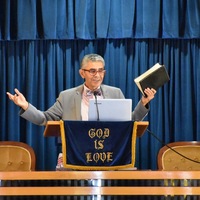
Roy E Gane
Professor of Hebrew Bible and Ancient Near Eastern Languages at the Seventh-day Adventist Theological Seminary, Andrews University. Specialty: Ancient Israelite rituals and biblical law.
less
Related Authors
Ted D Manby
Southeastern Baptist Theological Seminary
David J Hamstra
Andrews University
William Barrick
The Master's Seminary
Sergio Silva
Andrews University
Richard Averbeck
Trinity International University
Dr. Samuel Said
Union University
InterestsView All (6)









Uploads
Papers by Roy E Gane
First, the elaborate ordination of Aaronic priests elevated them to a
higher cultic status that authorized them to have more intimate access to
God’s presence than the laity. This elevation was for life, and it was only
for males. Second, the simple commissioning of Joshua, with handlaying,
authorized him to fulfill a representative leadership role for the
Israelite community. The New Testament only has equivalents to the
simpler commissioning ritual with hand-laying in order to authorize
administrators and missionaries for their tasks, with no indication that
they thereby gained elevated status in terms of access to God.
Absence of priestly ordination in the New Testament corresponds
with the absence of human priests as cultic mediators in the New
Testament Christian church. In the New Testament, the only priestly
mediator is the divine-human Christ, who ministers in God’s temple in
heaven (1 Tim 2:5; Heb 2:17; 4:14-15; 5:5-6, 10; 6:20; chs. 7-10). All
Christians comprise “a royal priesthood” (1 Pet 2:9; cf. Rev 1:6; 5:10;
20:6) in the sense that all Israelites were to be “a kingdom of priests”
(Exod 19:6). There are leaders in the Christian church, but they do not
have greater access to God than other Christians do, so an ontological
distinction between priests or ministers and laypersons does not apply to
New Testament Christianity. The tradition of sacramental ordination in
Christianity is not from the New Testament; it entered Christian tradition
from the Roman ordinatio (Latin) tradition after New Testament times.24
As mentioned above, God required Old Testament ordained priests
to be male, but there is no corresponding ordination with a gender
restriction in the New Testament. This is raw data, not subject to
interpretation. Therefore, debates about whether Christian women can be
ordained along with men are simply irrelevant and off target if
“ordination” is biblically defined as millu’îm.
First, the elaborate ordination of Aaronic priests elevated them to a
higher cultic status that authorized them to have more intimate access to
God’s presence than the laity. This elevation was for life, and it was only
for males. Second, the simple commissioning of Joshua, with handlaying,
authorized him to fulfill a representative leadership role for the
Israelite community. The New Testament only has equivalents to the
simpler commissioning ritual with hand-laying in order to authorize
administrators and missionaries for their tasks, with no indication that
they thereby gained elevated status in terms of access to God.
Absence of priestly ordination in the New Testament corresponds
with the absence of human priests as cultic mediators in the New
Testament Christian church. In the New Testament, the only priestly
mediator is the divine-human Christ, who ministers in God’s temple in
heaven (1 Tim 2:5; Heb 2:17; 4:14-15; 5:5-6, 10; 6:20; chs. 7-10). All
Christians comprise “a royal priesthood” (1 Pet 2:9; cf. Rev 1:6; 5:10;
20:6) in the sense that all Israelites were to be “a kingdom of priests”
(Exod 19:6). There are leaders in the Christian church, but they do not
have greater access to God than other Christians do, so an ontological
distinction between priests or ministers and laypersons does not apply to
New Testament Christianity. The tradition of sacramental ordination in
Christianity is not from the New Testament; it entered Christian tradition
from the Roman ordinatio (Latin) tradition after New Testament times.24
As mentioned above, God required Old Testament ordained priests
to be male, but there is no corresponding ordination with a gender
restriction in the New Testament. This is raw data, not subject to
interpretation. Therefore, debates about whether Christian women can be
ordained along with men are simply irrelevant and off target if
“ordination” is biblically defined as millu’îm.
In this volume, Christian scholars offer a deep resource of material—biblical, clinical, and legal—to untangle the complex web of questions surrounding this contested topic. The authors first provide a frank and rigorous explication of the Bible’s clear teaching. Then they lay out the implications for counseling and for the religious liberty of the church and its members. And through it all, they make an impassioned call for love and care for those who are being misled into a walk down a dangerous path. The book includes moving testimonies from several Christians who have lived and struggled with homosexuality in their personal lives and can praise God for empowering them to live for Him.
In the threatening environment facing the church and society today, every Christian administrator, attorney, teacher, counselor, pastor, and congregational leader should read this book. "
Who's Afraid of the Judgment by Roy Gane, takes a fresh look at the book of Daniel and shows how God's character is vindicated in the judgment. It also shows the relationship between the gospel and the judgment, what difference the judgment makes in our lives as Christians, and answers many objections being raised today over 1844 and the little horn.
So how could the Israelites possibly question whether God was among them? They knew without a shadow of a doubt--they had seen His presence, heard His voice, and eaten the food He provided. Yet they were still inclined to act as if they had never gotten the memo!
Roy Gane fills in background details that help us understand their wilderness experience and God's sometimes-puzzling decisions. Not surprisingly, our journey parallels that of the Israelites--and we too must learn those same lessons before we enter the Promised Land."
The resulting fresh approach provides a controlled framework for interpreting rituals belonging to various cultures and for identifying bases of comparison between them. Two important innovations are:
1. Application of General Systems Theory concepts to study human rituals as hierarchically structured human activity systems.
2. Application of F. Staal's "ritual syntax"(developed in the context of Vedic studies) to ancient Near Eastern rituals.
The first part of Ritual Dynamic structure builds a theory and definition of ritual and a corresponding methodology for analyzing specific rituals in terms of their activities and the meanings attached to those activities. The second part illustrates this methodology and its usefulness for comparative studies by applying it to ceremonies belonging to three ancient Near Eastern festival days of cult purification: the Israelite Day of Atonement, the fifth day of the Babylonian New Year Festival of Spring, and the fourth day of the Hittite Ninth Year Festival of Telipinu.
Although Altar Call is based on nearly two decades of scholarly work, several features make it easy and enjoyable to read: (1) Clear language, many illustrations (humorous at times), some diagrams, and a study guide. (2) Direct encounter with the Bible itself. (3) Connects fresh scholarship with practical spirituality. (4) Explains step by step, without assuming that the reader begins with knowledge of the topic. (5) Forthrightly deals with highly controversial issues and challenges common assumptions, but in a positive way.
Beginning with 'ābh ('āb), “father,” and continuing through the alphabet, the TDOT volumes present in-depth discussions of the key Hebrew and Aramaic words in the Old Testament. Leading scholars of various religious traditions (including Roman Catholic, Lutheran, Reformed, Anglican, Greek Orthodox, and Jewish) and from many parts of the world (Denmark, France, Germany, Great Britain, Greece, Israel, Italy, the Netherlands, Norway, Sweden, Switzerland, and the United States) have been carefully selected for each article by editors Botterweck, Ringgren, and Fabry and their consultants, George W. Anderson, Henri Cazelles, David Noel Freedman, Shemaryahu Talmon, and Gerhard Wallis.
The intention of the writers is to concentrate on meaning, starting from the more general, everyday senses and building to an understanding of theologically significant concepts. To avoid artificially restricting the focus of the articles, TDOT considers under each keyword the larger groups of words that are related linguistically or semantically. The lexical work includes detailed surveys of a word’s occurrences, not only in biblical material but also in other ancient Near Eastern writings. Sumerian, Akkadian, Egyptian, Ethiopic, Ugaritic, and Northwest Semitic sources are surveyed, among others, as well as the Qumran texts and the Septuagint; and in cultures where no cognate word exists, the authors often consider cognate ideas.
TDOT’s emphasis, though, is on Hebrew terminology and on biblical usage. The contributors employ philology as well as form-critical and traditio-historical methods, with the aim of understanding the religious statements in the Old Testament. Extensive bibliographical information adds to the value of this reference work.
This English edition attempts to serve the needs of Old Testament students without the linguistic background of more advanced scholars; it does so, however, without sacrificing the needs of the latter. Ancient scripts (Hebrew, Greek, etc.) are regularly transliterated in a readable way, and meanings of foreign words are given in many cases where the meanings might be obvious to advanced scholars. Where the Hebrew text versification differs from that of English Bibles, the English verse appears in parentheses. Such features will help all earnest students of the Bible to avail themselves of the manifold theological insights contained in this monumental work.